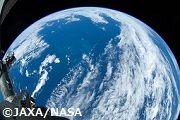| タイトル | Light-scattering properties of cluster-cluster aggregations |
| その他のタイトル | クラスタ-クラスタ凝集の光散乱特性 |
| 著者(日) | 寺尾 貴道 |
| 著者(英) | Terao, Takamichi |
| 著者所属(日) | 北海道大学 工学部 応用物理学科 |
| 著者所属(英) | Hokkaido University Department of Applied Physics, Faculty of Engineering |
| 発行日 | 2000 |
| 発行機関など | The Institute for Solid State Physics, The University of Tokyo
東京大学物性研究所 |
| 刊行物名 | Activity Report, 1999
Activity Report, 1999 |
| 開始ページ | 214 |
| 刊行年月日 | 2000 |
| 言語 | eng |
| 抄録 | The Cluster-Cluster Aggregation (CCA) model describes sol-gel transition due to a nonequilibrium process. When the particle concentration c is larger than a characteristic gel concentration c(sub g), an aggregate spans a box from edge to edge and forms a gel network. The CCA model is the most successful one for understanding the gel formation. This model produces clusters with scale invariance M(R) proportional to R(exp D(sub f)), where M(R) is a total mass of the cluster and D(sub f) is its fractal dimension. Static light-scattering measurement is powerful to clarify the structure of the cluster-cluster aggregations, which give useful information such as the average radius of gyration. Computer simulations on the optical properties of three dimensional reversible cluster-cluster aggregations and also the irreversible aggregations for comparison were performed. The profiles of scattering intensity I(q) on the aggregations were numerically obtained. After sufficiently long time steps, the intensity I(q) has no peak on reversible aggregations in the observed q (the absolute value of wave vector) regime, but there is a definite peak on irreversible aggregates in the q dependence. The peak intensity increased with the decreasing sticking probability, which showed that the structure of clusters became more compact. These results clarify that the light scattering properties on reversible cluster-cluster aggregations is apparently different from that on the irreversible ones.
クラスタ-クラスタ凝集(CCA)モデルは、非平衡過程によるゾル-ゲル転移を説明する。粒子濃度cが特性ゲル濃度c(sub g)より大きいとき、凝集は箱の端から端まで広がり、ゲルネットワークを構成する。CCAモデルは、ゲル形成を理解する上で最も成功を収めている。このモデルはM(R)がR(exp D(sub f))に比例するというスケール不変性によりクラスタを形成する。ここで、M(R)はクラスタの全質量であり、D(sub f)はフラクタル次元である。静的な光散乱の測定はクラスタ-クラスタ凝集体の構造の解明に有力な手段であり、ジャイレーションの平均半径のような有益な知見を得ることができる。著者は3次元の可逆的クラスタ-クラスタ凝集の光学的性質に関し、また比較のため非可逆凝集についても、コンピュータシミュレーションを行った。凝集体についての散乱強度のプロファイルI(q)を数値的に求めた。十分に長い計算ステップの後に散乱強度I(q)のピークはq(波数ベクトルの絶対値)の計算範囲では可逆的凝集の場合観測されなかった。しかし、不可逆的凝集ではq依存性に明瞭なピークが見出された。ピークの強度は付着確率の減少と共に減少し、クラスタ構造がよりコンパクトになっていることを示した。これらの結果は可逆クラスタ-クラスタの光散乱特性が明らかに不可逆凝集のものと異なることを示している。 |
| キーワード | cluster cluster aggregation; sol gel transition; cluster cluster aggregation model; diffusion limited cluster cluster aggregation; reaction limited cluster cluster aggregation; light scattering experiment; light scattering intensity; sticking probability; クラスタ-クラスタ凝集; ゾル-ゲル転移; クラスタ-クラスタ凝集モデル; 拡散律速クラスタ-クラスタ凝集; 反応律速クラスタ-クラスタ凝集; 光散乱実験; 光散乱強度; 付着確率 |
| 資料種別 | Technical Report |
| SHI-NO | AA0002233102 |
| URI | https://repository.exst.jaxa.jp/dspace/handle/a-is/56660 |

